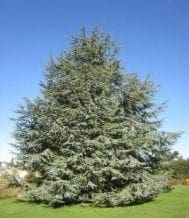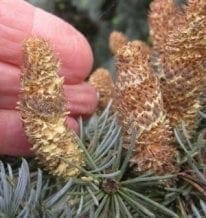Atlas Cedar tree identification
The Atlas Cedar Cedrus atlantica is a conifer, native to the Atlas Mountains in Algeria and Morocco, where it grows at an altitude of 1300 to 2200m. It was introduced to Britain before 1840. It is now very common in old parks, churchyards and gardens of all sizes. It is often in the ‘glauca’ form known as the Blue Atlas Cedar, shown here. Atlas Cedar tree identification is by its needles, cone and overall shape. The needles are in clusters, the cones are barrel-shaped and the branch-ends usually point upward. The normal wild form is uncommon and has deep green needles. There are only three ‘true’ Cedars you are likely to see – the Atlas Cedar, the Cedar of Lebanon and the Deodar. They can be difficult to tell apart but generally Atlas Cedars have upward pointing tips to their branches, Deodar’s tips point downwards and those of the Cedar of Lebanon are flat. ‘True’ Cedars are the only autumn-flowering conifers. Male ‘flowers’ shed pollen in October or November. ‘True’ Cedars are members of the genus Cedrus. They have needles in clumps of from 20 to 45 on short shoots called spurs. ‘False’ Cedars such as the Incense Cedar, Western Red Cedar and Japanese Red Cedar are called ‘cedars’ because they have wood that smells and looks like the wood of the ‘true’ cedars. In fact they have scale-like leaves quite different from those of the ‘true’ cedars.





